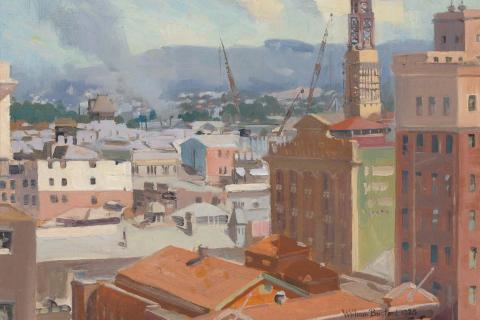Fischli & Weiss’s frosty Snowman
By Sophie Rose
June 2019
Peter Fischli and David Weiss’s frosty, toy-like Snowman 1987/2017–19 is in fact an encased water system, marked by controlled cycles of condensation, precipitation and freezing. The snowman is trapped in a steel vitrine so that he will never melt, defying the natural conditions around him. This fake snowman is also a delicate object that must be cared for — carefully frosted and defrosted, with his smile reconstructed by others each day.
Fischli and Weiss are renowned for their humorous metamorphoses of the commonplace. Working across sculpture, installation, moving image and photography, they imbue mundane objects with animism, finding unexpected narratives in a spiral of women’s shoes (Flirtation, love etc. 1984) or uneaten sausages (‘Sausage’ series 1979). At first, Snowman might seem like just another of their artistic jokes and, indeed, there is a Duchampian wink behind this fridge-cum-sculpture. However, beneath the whimsy, Snowman suggests we cultivate an ethos of care in a rapidly warming planet.
In 1987 the Swiss duo conceived of an artificial snowman that would remain frozen all year round. The sculpture was originally designed to stand outside the Römerbrücke thermal power station in Saarbrücken, Germany. Paradoxically, the power (and heat) produced by the factory would keep the snowman perpetually frozen.1 In 2017 Peter Fischli was commissioned by the San Francisco Museum of Modern Art to remake the work. The twenty-first century Snowman is constructed from three copper spheres contained behind the transparent glazing of a large freezer. As the frost gradually accumulates upon the spheres, the snowman grows in size until he needs to be defrosted, shrinking down once more. His smile must be redrawn each day so that his expression does not fade within the layers of ice. The figure of the snowman has a long history. From The Miracle of 1511 — a festival in Brussels where the locals made more than 100 satirical snowmen — to the popular Christmas song ‘Frosty the Snowman’, the anthropoid figure has long captured the public imagination.2 As Fischli observes, the snowman is a ‘sculpture that almost anyone can make’.3 In this way, he is a kind of readymade: no matter who constructs him, he will remain an age-old (and authorless) form, linked to thousands of snowmen made before him.
Why do we possess this desire, seemingly innate, to sculpt a person out of snow? Snow is a mouldable material waiting to be shaped; much like clay or sand, it invites us to make sculpture, however rudimentary. In the snow we build an object in our likeness, animating the cool, icy substance. With three snowballs, some twigs and maybe a carrot, we mark a human presence upon the land.
And yet each snowman is at the mercy of his surrounds — always doomed to crumble under the kick of a child, or to melt as the temperature rises throughout the day, and seasons change. Fischli and Weiss artificially preserve this ephemeral object, making it permanent in a way that seems absurd, if not a little perverse. Snowman is comically out of place in subtropical Brisbane; many Australians will have never seen a snowman in real life. Yet his presence is no less plausible than the Gallery’s year round air-conditioning. If we can buy flowers and fruit out of season and remain at a comfortable 23 degrees Celsius all year round, why not have a snowman in summer? This is a question the Snowman asks, held within his cool, powered enclosure.
Sophie Rose is former Assistant Curator, International Art, QAGOMA.
Endnotes
- Beat Wyss, ‘Melting beauty’, in Fischli & Weiss: Flowers & Questions. Tate Publishing, London, 2006, p.181.
- The first image of a snowman appears in medieval manuscript; however, the figure has probably always existed in snow-covered areas (Bob Eckstein, ‘The snowman as modern art’, The New Yorker, 1 June 2017, viewed July 2019).
- 'If Everything Is Sculpture Why Make Sculpture? Artist’s Choice: Peter Fischli', MoMA, viewed October 2019.
Connected objects

Snowman 1987/2017-19
- FISCHLI, Peter - Artist
- WEISS, David - Artist
Metadata, copyright and sharing information
About this story
- Subject
